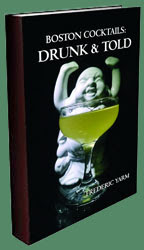
Earlier today, the Bartender's Breakfast marked the conclusion of the second annual Thirst Boston, but for me the event ended with the afterparties on Sunday night for I needed to work and open a bar on Monday morning after taking the whole weekend off from Friday evening on. I have only taken a few short moments to reflect on the past few days given the whirlwind adventure between my barshifts on Friday and Monday, and here are some of the highlights:

•
Best Part of The Thing: The Secret Bar. For the first The Thing, there were
three rooms: an entry vestibule, the main hall, and then the #DTO room. This year, there were only two; however, somewhere towards the end of the night, a small window -- something between a coat check or a cafeteria window in style -- opened up and there was Charles Joly serving "A Cocktail." I did see photographic evidence that Jon Santers was making drinks too, but I only caught Charles making an agave Corpse Reviver.
•
Old Faces: A good number of Boston ex-pats came back to attend and/or volunteer for the weekend. For example, I was impressed that Lea Madda and Chad Arnholt traveled from California to be there and give their time to help out.
•
Best Recurrent Concept: Pop-ups! The first cool one was on Saturday for the State Lines: A Portland (Maine) and Providence (Rhode Island) Pop-up. Several bars both cities had tables demonstrating their tone, displaying their food and drink menus, and showcasing a trio of drinks to try. Best swag from that event was an Allen's Coffee Brandy knit hat from the Portland Hunt & Alpine Club in Portland. Moreover, on Sunday night was an Amor y Amargo pop-up featuring bartender Souther Teague and the Fernet Branca portfolio (pictured below). The Boston Shaker pop-up store was a great thing for those visiting, but a good deal of us are blessed with having that store so close by and accessible.

•
Best General Talk: The Re-emergence of Rum. Besides a star-studded cast of characters -- Misty Kalkofen, Charles Joly, David Wondrich, Joaquin Simo, Maggie Campbell, and Wayne Curtis -- it was a great mix of distiller, bartender, and historian that gave a great perspective on the spirit that was a good supplement to last year's
Rum: The World's Most Versatile Spirit talk. I will be covering that talk in greater detail soon.
•
Best Industry Talk: The Three Phases of Hospitality. With Andy Seymour as the spirited moderator, Joaquin Simo, Jon Santer, and Sean Kenyon spelled out great concepts from how your bar is laid out to menu design to help make the guest feel more comfortable. Of course, in addition to how to productively interact with guests to make them feel at home. I won't spoil too much of this talk now, so have patience for when I can do it justice with a long write-up.
•
Not What I Was Expecting Talk: The Aperitif Hour with Naren Young and Nick Korn. I was expecting more about the history and importance of aperitifs, but I was pleasantly surprised by how it was more about making these drinks special for our guests. From seasonal variations to care in garnish as well as from bottling cocktails to unsung heroes of the aperitif hour like the
Jasmine. Naren's point could be summed up in the quote, "Everyone can make great drinks. Remember, we're selling experiences."

•
Best Snide Comment from Matt Schrage: Yes, this needs to be a category. Matt Schrage, founder of the Mocktail Virgin/Slut blog, at the "From Medicine to Libation: The Art of Preparing Vermouth" seminar commented about my early vermouth blend, "Smells like you're washing your terrier (dog) in Sprite™... Good job, Fred!"
•
Great Way of Thinking About Cocktails: While Stephen Shellenberger has divided the lot as whether people like the softer taste of Snapple™ or the acid backbone of wine, Diego Loret of Barsol Pisco at "Importing Awesome - The World's Next Great Spirits" made the differentiation of "Do you love green apples or red?"
•
Blast from the Past Moment: Reaching into the pocket of my smoking jacket that I wore to The Thing and finding the pamphlet guide from the LUPEC's Boston Tea Party speakeasy event from fall 2007. It was LUPEC-Boston's first event and wearing that jacket landed me on the
DrinkBoston blog; several of the LUPEC-Boston broads were at The Thing and were quite touched by seeing that keepsake!
•
Absurd Drink Award: Not sure whether Ran Duan handing me a Piña Colada in a green coconut cup replete with a two foot neon straw in the front room of The Thing or the 50-50 Martini laybacks in the back room of that event.

•
Surreal Bar Remake: The Absolut/Pernod Ricard afterparty at the Hawthorne where they converted it to a Studio 54 tribute!
•
Coolest Find: Finding photos of the old carousel Boston that was in Boston (in the hotel Thirst was held in) -- see my
Tweet for the image. I knew that there were many carousels in the world and that Boston had one (although the Monteleone one might be the only one left), I didn't realize that I would be in that hotel and in that room this past weekend!
•
Biggest Confusion: No, it wasn't how to get to Copley with various parts of the Red and Green Lines down for the weekend (thanks MBTA!), but it was in going to work this morning. I tried to catch my wife up on my weekend and was about to head out the door with my trusty backpack that served me quite well all weekend (as well as daily carry to work) when she pointed out that I hadn't picked out or packed a dress shirt, vest, and tie combo. Whoops! I guess that's what too little sleep will do for you...
 MXMO XCII: Apples!
MXMO XCII: Apples! Here's how to play:
Here's how to play:









 The theme for this month's
The theme for this month's 

 One of the most valuable talks at this year's Thirst Boston for me as someone in the service industry was "The Three Phases of Hospitality." Moderator Andy Seymour led the three pronged attack with Jon Santer of Bourbon & Branch and Prize Fighter fame discussing everything that can be done before a guest walks into the establishment, Joaquin Simo of Death & Co. and Pouring Ribbons fame focusing on what can be done once the guest is inside, and Sean Kenyon of William & Graham expounding on crafting a culture and community to foster hospitality.
One of the most valuable talks at this year's Thirst Boston for me as someone in the service industry was "The Three Phases of Hospitality." Moderator Andy Seymour led the three pronged attack with Jon Santer of Bourbon & Branch and Prize Fighter fame discussing everything that can be done before a guest walks into the establishment, Joaquin Simo of Death & Co. and Pouring Ribbons fame focusing on what can be done once the guest is inside, and Sean Kenyon of William & Graham expounding on crafting a culture and community to foster hospitality.













 Jigger 2/3 Sherry (1 1/2 oz Lustau Dry Oloroso)
Jigger 2/3 Sherry (1 1/2 oz Lustau Dry Oloroso)


 The 2017 collection of 855 drink recipes, bartender tributes, and essays on hospitality from CocktailVirgin's Frederic Yarm. Available at
The 2017 collection of 855 drink recipes, bartender tributes, and essays on hospitality from CocktailVirgin's Frederic Yarm. Available at  The 2012 collection of 505 drink recipes, techniques, and Boston bar recommendations from Frederic Yarm. Available at
The 2012 collection of 505 drink recipes, techniques, and Boston bar recommendations from Frederic Yarm. Available at 



